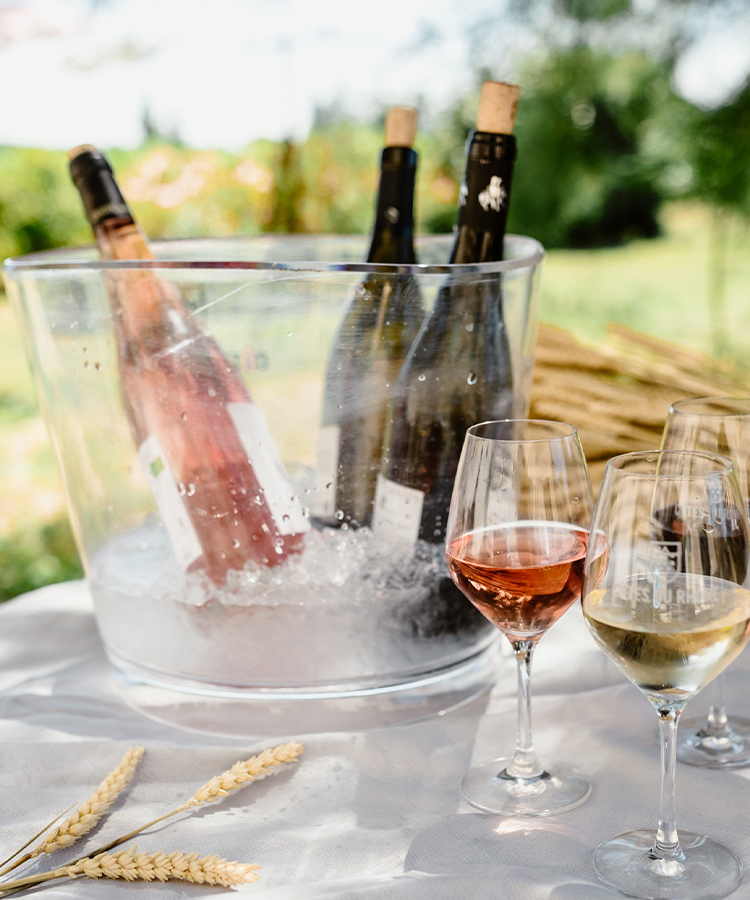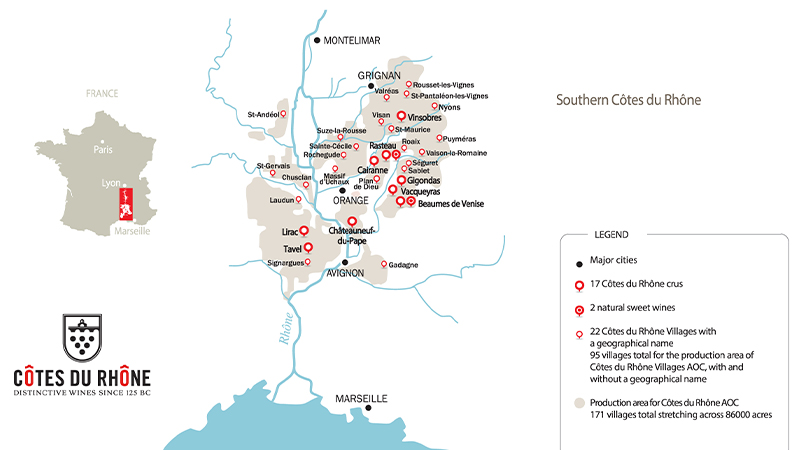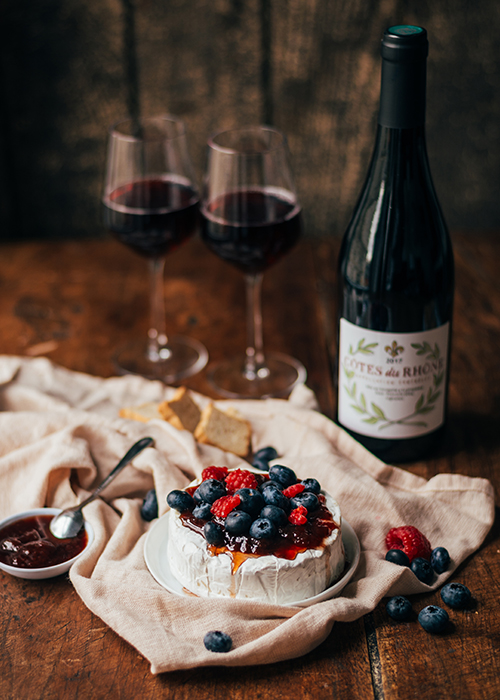
Yeah, it got a little desperate when our Netflix reservoir seemed to dry up, but the year-plus (mostly) at home has had its silver linings. For instance, we got to go full throttle on our “sideline” culinary passions, and while that means there are probably thousands of sourdough starters that never rose past “tart lump” stage, there’s also been a massive reinvestment in wine, on all skill levels. And where palates go looking for serious wine to play in, they find the Côtes du Rhône. Newbie wine lovers dipped their toes in and longtime wine drinkers dove into the deep end.
Lucky for everyone, the reservoir of Côtes du Rhône never dries up. It’s the kind of wine region that never stops offering diversity and bounty, not to mention pairability, making it ideal for any occasion, meal, mood, etc.
In fact, we wanted to write a Côtes du Rhône buying guide, but we realized, with its hundreds of wineries and the vast offerings of Côtes du Rhône you can currently find in the U.S., it would be a shame to pick just a few bottles. Instead, we’re embracing it all, celebrating it all. And we mean all.
Color
First of all, its colors. Côtes du Rhône is most famous for its reds, but it also comes in white and rosé, increasingly in fact. The reds are easiest to find in any retail store, even a well-stocked supermarket wine section. They’re also congruently easy to appreciate, with Côtes du Rhône reds often expressing soft tannins, ready fruit, and subtle spice aromas that seem like they should belong to a more expensive bottle.
White Côtes du Rhône wines aren’t to be missed. In fact, white wine lovers slightly fatigued on one-note buttery Chardonnay or lemony Pinot Grigio should hunt them down. They’re a veritable gold mine of complexity thanks to a large palette of aromas coming from the many varietals winemakers grow in the Côtes du Rhône and apply — like true craftsmen — to the final blend. Where Chardonnay and Pinot Grigio in the same price point play one-note melodies, Côtes du Rhône white wine blends are symphonic.
Côtes du Rhône rosés, too, are melodic, and blended with food and pairing in mind. While major Côtes du Rhône blending grapes like Grenache and Mourvèdre enjoy a Mediterranean climate, Côtes du Rhône rosés are often a little fuller, rounder, and darker than the typical light-hue Provencal rosé, making them more flexible in pairing — capable of answering richer dishes, darker proteins, heavier levels of spice and seasoning.
Blends & Varietals
If you needed to pare it down to a simple formula, the kind of thing you can explain over a dinner party with clinking glasses, it’s this: The Côtes du Rhône is famous for its winemakers’ ability to blend three prominent red grapes: Grenache, Syrah, and Mourvèdre. Those grapes make up the bulk of a Côtes du Rhône red blend, but winemakers also choose between twenty other authorized grapes. And it’s that combination — of 23 grape varietals — that determines a Côtes du Rhône wine’s final character. Needless to say, it’s an art.
All Its Identities & Characters
Another fun fact for a dinner party: Like a Russian nesting doll, Côtes du Rhône is an appellation, with a smaller appellation inside, and an even smaller appellation inside of that. For the largest appellation, “Côtes du Rhône,” the labels simply says “Côtes du Rhône” along with other winery information. The next-largest appellation, “Côtes du Rhônes Villages,” comes from a smaller number of villages that have to adhere to stricter production standards. (If you see “Villages,” capitalized like that, it’s from this region.)
Within the Côtes du Rhône Villages appellation, there is an extra tier that allows some villages to add their name on the label. This is where you find the most terroir-centric production in the region. In fact, only 22 villages enjoy the privilege of having their names on the bottle. Not only does that mean the wine is made with ultra-strict production standards, but winemakers within the appellation are passionately expressive. In any bottle within this appellation, you’ll find as much personality as exquisite blending technique — and you get the fun of deciding which you like best.
Côtes du Rhône’s Best Friend: Food
Whatever the shade or appellation, Côtes du Rhône wines pair beautifully with light fare — fish (fatty, crustaceans, battered and fried) as well as all manner of vegetables (grilled, roasted, pureed, pickled). In fact Côtes du Rhône reds have that fleshy berry flavor, plus carefully dialed-in acidity and restrained tannins, making them highly pairable with a variety of cooking styles.
If you venture into the Côtes du Rhône Villages tier, pair any color with herb-crusted chicken thighs, and reserve a red or rosé with lamb chops or barbecue pork (the spices will sing against the smoke you can find in Syrah). Venture into the Côtes du Rhône Villages-plus-village-name tier and you’ll have yet more character to play against finer points of flavor and texture in a dish, or several courses. In fact, like a very good dinner guest, the wines themselves are nimble and keep things lively from dish to dish.
Not to mention, as cold weather comes, it’s essential to remember Côtes du Rhône reds with all kinds of game meat, stews, and any kind of forest-y, berry-flecked, herbaceous sauce or side that might accompany them. It’s the kind of supple, fleshy red you’ll want at your cozy dinner table, and the kind you’ll be able to take from the table to a chair by the fire (or radiator) to sip and savor even as the temperatures drop.
Buying Tips: Want Fun Wine? Reach for “Côtes du Rhône”
In terms of broad strokes, of course, there are some general rules to remember: If you’re looking for a supple, fruitier wine, your best bet for a red wine is a blend dominated by Grenache or Mourvèdre. That means more dark fruit — black cherry and plum — with carefully balanced acidity, not unlike certain Californian red blends (that are similarly perfect for fresh, local pairing). Syrah-dominant wines can be spicier and delicately-muscled, and should be stocked up on as cold weather approaches.
To the same points, the white and rosé from the AOC Côtes du Rhône will deliver a richness of aromas and texture —balancing acid and fleshiness — making Côtes du Rhône white wine and rosés viably strong partners for a wide variety of dishes. And of course, it’s useful to remember that for a Côtes du Rhône rosé, the darker it is, the more it has a chance to marry very well with food.
Easy to Explore
Yes, there’s a lot of rich variety within the Côtes du Rhône, but it’s easy to learn your way around. For instance, in the Côtes du Rhône Villages-plus-village appellation, there are currently six villages widely available in the U.S.: Visan, Sablet, Valréas, Laudun, Séguret, and Plan de Dieu. Those names on bottles of Côtes du Rhône mean the wine inside is from one of the 22 villages that have earned the right to print their names — and the wine inside is inevitably beautiful, interesting, and full of character.
You will find some gastronomic white and rosé wines, as well as reds you can enjoy after a few years in a cellar. The whites have a distinctive freshness because many of the vineyards are planted at a higher altitude than the rest of the AOC Côtes du Rhône. The rosés, leaning darker, can go from summer to fall and drink readily, generously, any season you open them.
To get you started on your scavenger hunt, we’ll share a few hidden gems: Try whites from Côtes du Rhône Villages Laudun, a rosé from Côtes du Rhône Villages Séguret, and a red from Côtes du Rhône Villages Plan de Dieu
Whether you plan to pair or sip alone, remember to serve your Côtes du Rhône reds a little cooler than room temperature. And if you’re lucky enough to find a Côtes du Rhône white or rosé, you’ll want to chill them, but delicately (no ice cubes, please!).
And if you do decide to explore the Côtes du Rhône, don’t delay. Not only is it a wine enthusiast’s dream, but it’s an incredible value. For prices that mean you can buy more than one bottle — explore two villages at once, try a red and a rosé, etc. — you’re getting a gold mine of tradition and complexity. You’ll want to learn them, and immediately put them on heavy rotation.
Discover more about Côtes du Rhône here!
This article is sponsored by Côtes du Rhône.


